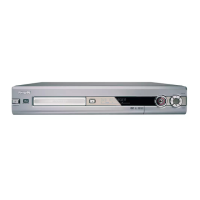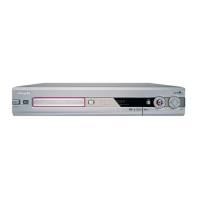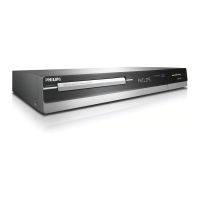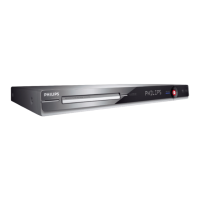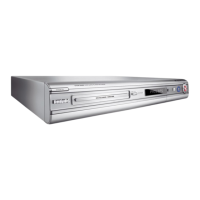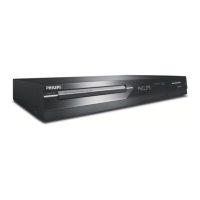EN 170 3139 785 315329.
Circuit- and IC Description
SAA7118E
7007
CHRYSALIS
PNX7100EH
7400
SDRAM
HDD
7812
133MHz
SDRAM
7813
1394 LINK
7201
AUDIO PLL
7301
1394 PHY
24.576 MHz
24.576 MHz
7200
4 MHz
BASIC
ENGINE
IDE1
IDE2
Figure 9-5 Clock Distribution
The Chrysalis chip has a complex system, which is needed to
support the processes running at different frequencies such
as video decoding, audio decoding or peripheral I/O devices
etc. To ensure a synchronous initialization of all the registers
and state machines, all the PLLs are switched to their default
frequency and the reset sequence is run at 4MHz.
Then when the booting control unit is correctly initialized and
once it has captured all the booting parameters, it sets the
PLLs to its functional frequencies to allow the modules to
run at their nominal frequencies. Thanks to a clock blocking
mechanism, the frequency switching is glitch free.
System clocks:
• PNX7100EH (7400, pin AF9 and AF10) : 4MHz provided
by the x’tal 1401
• SAA7118E (7007, pins A3 and B4) : 24.576MHz provided
by x’tal 1001
• 1394-PHY (7200, pins 59 and 60) : 24.576MHz provided
by x’tal 1201
• 1394-LINK (7201, pin 88) : 49.152MHz provided by
1394-PHY
• SDRAM (7812 and 7813, pin 38) : 133MHz provided by
the Chrysalis chip
Video Part
The analogue video input signals CVBS, YC and RGB are
routed via the board to connector 1904 and sent to Video
Input Processor, SAA7118E. The Video Input Processor
encodes the analogue video to digital video stream (CCIR656
format). The output stream, named ITU_IN(7:0), is then
routed to the Chrysalis chip. This IC encodes and decodes
the digital video stream into / from MPEG2 format.
The digital video input signals from the DV-in are routed from
connector 1203 via the 1394 PHY IC [7200] and the 1394
LINK IC [7201] also to the Chrysalis chip.
Audio Part
I
2
S audio is sent from the Analog board to the Chrysalis chip
via connector 1900.
The Chrysalis chip compresses the I
2
S audio data into an
MPEG1-L2 / AC3 audio stream.
Front-end I
2
S
The Chrysalis chip interfaces directly to the Basic Engine and
HDD via the IDE connectors.
It buffers the data streams that are coming from (or going to)
these hardware devices.
In the Chrysalis chip, the video MPEG2 stream and the audio
AC3 stream are multiplexed into an I
2
S stream. In normal
recording the serial data are send to the HDD for recording.
Only archiving and playback is done with optical drive.
9.5.2. Playback mode
During playback, the serial data from the Basic Engine is
going directly to the Chrysalis chip via ATAPI interface. The
Chrysalis chip has the following outputs:
• Analog video CVBS, YC and RGB outputs on
connector 1904
• I
2
S audio (PCM format) on connector 1900
• SPDIF audio (digital audio output) on connector 1900
• Progressive Scan output connector 1002
9.5.3. Basic Engine Interface
The Digital board is equipped with 2 IDE bus (ATAPI) for
connecting to the Basic Engine and HDD via connectors 1102
and 1101 respectively.
9.5.4. Clock Distribution
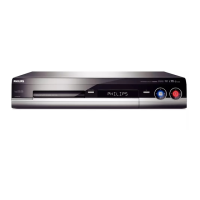
